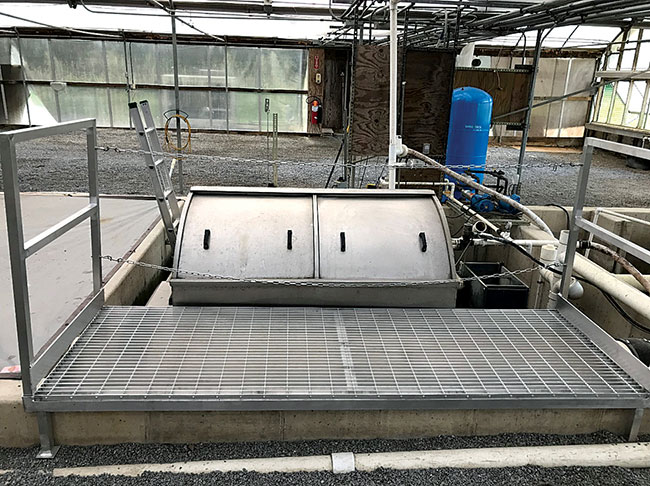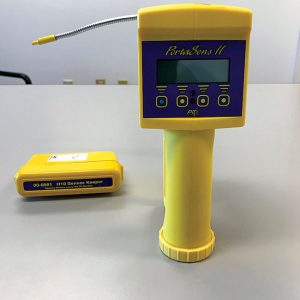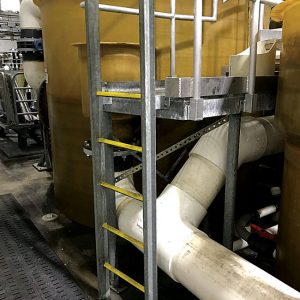
Features
Safety first: Keeping safe in a RAS facility
October 21, 2021 By Travis May
 Fall protection around a microscreen drum filter Photos: The Freshwater Institute
Fall protection around a microscreen drum filter Photos: The Freshwater Institute
Operators at recirculating aquaculture system (RAS) facilities can encounter a variety of safety challenges. Hazards and risks range from slips, trips, and falls, to toxic gas inhalation, drowning, and chemical exposure, among others.
Not only are injuries harmful to employees and their families, but they can also negatively impact profitability through decreased worker productivity, increased insurance costs, and in some cases, legal fees and damages to company reputations.
Worker safety should be prioritized and planned for, as RAS facilities increase in size to capitalize on the benefits of economies of scale. This article discusses simple practices that are designed to enhance worker safety and prevent injuries in and around RAS facilities.
Design for safety
Worker safety should start during RAS facility design. It is important to consider how fish production staff will safely execute important tasks such as harvesting, system cleaning, and feeding fish when designing and building a facility.
For example, working height of routinely used equipment such as fish feeders, water quality probes, and unit process access points must be considered before facility construction. Installing feeders too high or out over tank openings can increase risk of back injuries as workers attempt to lift heavy feed bags to fill feed hoppers.
Additionally, equipment and access points may require a stool or ladder, increasing risks of falling. An elevated platform can provide safe access to fish and equipment around large tanks at an optimal height for worker safety. Elevated platforms can be constructed using anti-slip grating to prevent injuries from pooled water and wet surfaces. Designed to comply with safety regulations, railings should be strategically placed around elevated platforms to prevent falls.
RAS operators routinely climb ladders to clean components at the top of the system or check feed supplies within a silo. Ladders should be equipped with a safety cage to prevent falls, and rungs furnished with anti-slip measures. Self-closing safety gates should be installed at the entry to the platform accessible by a ladder, preventing falls down the ladder chute. Another area where fall protection is important is in and around microscreen drum filters and similar equipment with rotating components. This type of equipment produces significant mechanical torque to rotate the drum during a backwash cycle. Caution must be taken to ensure that hair, clothing, or other loose materials aren’t caught and pulled into the rotating components. Platforms with railings are recommended around this equipment to ensure that staff do not lose balance and fall into the filter.
Work safely
Unavoidable safety hazards at a RAS facility may include noise and risk of drowning in large, deep fish culture tanks. Noise from pumps, blowers, and the constant droning of cascading water can have adverse effects on workers’ hearing. To protect employees, facilities should regularly test sound levels using a sound meter or dosimeter. U.S. Occupational Safety and Health Administration (OSHA) guidelines state that a hearing conservation program must be administered if employee noise exposure is equal to or exceeds an eight-hour time weighted average sound level of 85 decibels. At or above this level, the employer must make hearing protection available.
The risk of drowning is always present when working around water. Large fish tank sizes, fast water velocities, and unknown interactions with a large biomass of fish could make it difficult for even an experienced swimmer to reach safety should they fall into a tank. Flotation devices and rescue life hooks or rings should be easily accessible around tanks, to be thrown or extended if a worker has fallen in.
Additionally, first aid training conducted by a reputable provider such as the Red Cross or American Heart Association is recommended annually for key staff members. OSHA-approved first aid kits should be in each building at easily accessible locations. First aid kits should have enough supplies to ensure everyone working in the area is covered, and include a program to check supplies periodically to replace expired items or restock inventories.
The potential for life-threatening emergencies at any RAS facility requires an emergency response plan. A basic plan consists of:
- a list of emergency contacts with phone numbers of key personnel including the operations manager, hatchery/fish production manager, local first responders, and state regulatory authorities, as well as critical utility vendors including electrical power, propane, and industrial gas companies;
- a centralized meeting location outside of buildings and far enough away from any danger, where all staff members can be accounted for (i.e., a muster point).
Breathe safely
Some RAS facilities use hazardous gases like ozone (O3) for water treatment. O3 gas may be generated onsite and applied in RAS systems to microflocculate particles and fine colloidal solids. Leaks in O3 supply lines can result in dangerous levels of O3 inside a building. OSHA has set a permissible exposure limits as an eight-hour, time weighted average value of 0.1 ppm for O3 gas. Ambient O3 gas detectors should be installed around fish production tanks near ground level adjacent to O3 injection points, such as a low head oxygenator sump or foam fractionator. Ambient O3 monitors should be calibrated annually or more frequently if recommended by the manufacturer, and spare parts should be kept on hand for quick repairs. Additionally, continuously operating ambient O3 detectors should be connected to an alarm that’s both audible and visual, and buildings be equipped with high-volume ventilation fans and O3 generator shutoff switches, which automatically turn on and stop the flow of O3 gas during an alarm condition, avoiding additional danger to workers.
The gas hydrogen sulfide (H2S) can form in fresh and saltwater RAS facilities and associated wastewater treatment systems. H2S can form when solids are degraded by anaerobic bacteria, resulting in a highly toxic and flammable gas that can displace oxygen and rapidly overcome unprepared workers. According to OSHA, this gas is the leading cause of workplace gas inhalation deaths in the U.S. Staff can risk encountering toxic H2S when entering confined spaces, such as tanks and pump sumps (particularly those containing organic solids) for routine cleaning between production cycles, or when performing maintenance tasks. Identify and label all confined spaces as part of a confined space safety program. Entry into confined spaces should adhere to a well-defined standard operating procedure, which requires two people. The procedure includes testing the area’s air for H2S levels, other airborne contaminants, and appropriate oxygen levels with a handheld meter, prior to entering. If H2S levels are higher than OSHA’s exposure limit, the space will need to be ventilated outside of the building using an explosion proof ventilation system. Once ventilated, the area should be retested to ensure that it is safe to enter. While working within the area, H2S and oxygen levels should be continuously monitored.
Final thoughts
There are important safety concerns and associated preventative measures to be considered in and around RAS facilities. This is not an exhaustive list of potential hazards and solutions. It is recommended that a comprehensive worker safety program be developed for any RAS facility. One of the first steps is to form a safety committee consisting of staff across multiple departments who will meet regularly to discuss existing or developing safety concerns, and guide the implementation of onsite safety policies.
This article expresses the opinions of the author based on his own experience, is informational-only in content, does not constitute advice or guidance specific to any one employer or facility, and is intended to assist generally employers and facilities in providing a safe and healthful workplace. All employers should comply with federal, state, local, and industry legal and regulatory safety and health standards, as well as having a safety plan based on their specific facility, equipment, employees, and particular needs.
Print this page







